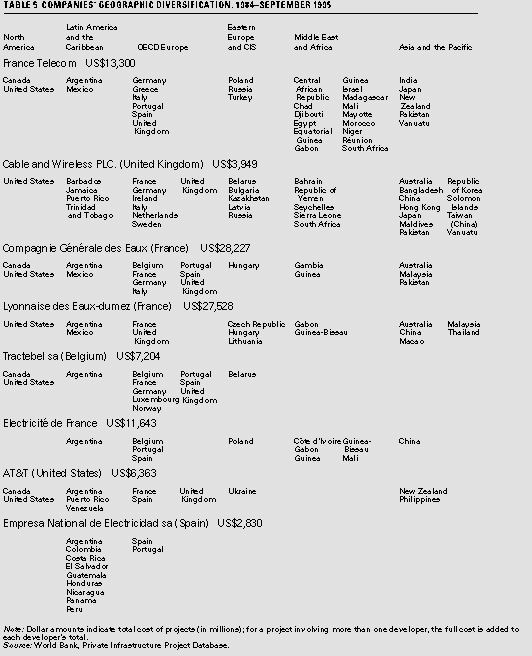
Jae So and Ben Shin
October 1995
The FPD Note series is an open forum intended to encourage dissemination and debate on ideas, innovations, and best practices relating to public policy issues in private and financial sector development. The views published are those of the authors and should not be attributed to the World Bank or any of its affiliated organizations. Nor do any of the conclusions represent official policy of the World Bank or of its Executive directors or the countries they represent.
The global private infrastructure industry has experienced rapid growth over the past fifteen years and attracted some 1,700 companies. Infrastructure was generally managed by national, single-sector utilities, but technological and regulatory change has allowed companies to cross traditional boundaries. Although core competencies in specific sectors are still important, companies are beginning to exploit new sources of competitive advantage, such as the ability to efficiently manage an integrated network of diverse services (table 1). Electric utilities in Germany—RWE, Viag, and Veba—are entering telecommunications markets on the strength of their extensive cable and electricity distribution networks and their experience operating massive, companywide internal telecommunications networks. WMX Technologies of the United States is adding wastewater treatment plants and waste-to-energy ventures to its waste management repertoire.

This Note briefly surveys the origins of some of these global infrastructure companies (see table 2 for the ten most active ones) and shows how major companies are diversifying across sectors and regions (tables 1 and 5). It also gives a flavor of the approaches companies use to compete in the evolving market and discusses some of the risks they face. [1]




The growth of some companies has its origins in recent deregulation and privatization. Many U.S. utilities, faced with an increasingly mature home market, are taking advantage of the Public Utilities Holding Companies Act of 1992, which allows them to venture into new markets. Privatization has prompted such companies as British Gas and British Telecommunications to seek additional shareholder profits in overseas ventures. Some investors are driven by a need for secure supply. Germany's largest gas company, Ruhrgas, is investing in countries key to regular supply--countries in Eastern Europe and the former Soviet Union. Other companies are taking advantage of a historical head start. French water companies, for example, are exploiting their long experience in operating private water concessions at home in newly private ventures abroad.
Many companies competing in private infrastructure markets are publicly owned at home, such as Électricité de France (see table 3 for the top ten developers with state ownership). Telefónica of Spain and France Telecom bid aggressively for telecommunications companies in emerging markets. And firms from emerging markets are themselves poised to become developers. Tribasa, a Mexican construction company, building on its toll road experience, acquired the capability to arrange financing and is branching out into other infrastructure ventures, including water supply and waste disposal (see table 4 for the top ten developers from emerging markets).
Companies such as Asea Brown Boveri and General Electric, traditional equipment suppliers for public and private utilities, are diversifying into project development so as to benefit from control over the entire project, rather than only bidding for the equipment contract in the final stages. Along with equipment suppliers, engineering companies such as Fluor Daniel and Black & Veatch are taking a more active role in financing projects previously in the public sector and in some cases are functioning as developers. And companies such as Hopewell Holdings have built on their experience as project managers to become project developers; able to build good working relationships with governments, they can expedite complex contractual arrangements in uncertain regulatory and legal environments.
From these origins, infrastructure companies are adopting a range of competitive strategies, from sectoral diversification based on core functional skills to a focus on subsectors and single functions:
Infrastructure companies face three key challenges. First, as companies adopt more of an ownership approach to infrastructure projects, they must have the ability to pull the deal together and connect the network of companies that will supply services. Development costs—mostly staff time and travel to put the deal together—can be 3 to 5 percent of the cost of projects worth several hundred million dollars. Second, to conclude a deal, companies must also be able to arrange a favorable financing package. Companies have approached the issue in a variety of ways. Asea Brown Boveri makes full use of export credit financing for its projects. Enron constantly pushes the frontier in tapping capital markets.
Third, although development teams breathe a sigh of relief once a project is funded and construction begins, regulatory problems may be just about to start. Highly visible problem cases have been Cogasco, a natural gas pipeline project in Argentina that went awry in 1982, and the more recent troubles of the Bangkok Expressway. In both instances, regulatory authorities failed to live up to the spirit of the contract. Whether the trend toward private infrastructure is sustained will depend on transparent and competitive solutions that render price regulation unnecessary or, where that is not possible, price regulation that balances the interests of developers, consumers, and governments. Ultimately, it is in the developers' interest to help establish the system that will regulate their behavior. Such companies as AT&T of the United States, Germany's RWE, and Hong Kong's China Light and Power have actively helped to develop regulatory solutions, which allowed them to deflect pressure for nationalization.
Jae So, Private Sector Development Specialist (email: jso@worldbank.org), and Ben Shin (email: bshin@worldbank.org), Private Sector Development Department
Comments are welcome. Please call the FPD Note line to leave a message: 202-458-1111; or contact Suzanne Smith, editor, Room G8105, The World Bank, 1818 H Street, NW, Washington, DC 20433, or at ssmith7@worldbank.org.